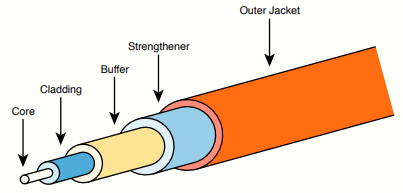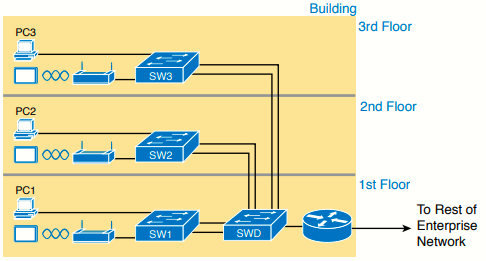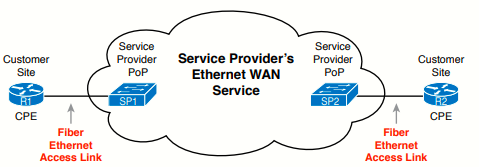Key notes on Network Fundamentals
- Same-layer interaction: The two computers use a protocol to communicate with the same layer on another computer. The protocol defines a header that communicates what each computer wants to do.
- Adjacent-layer interaction on the same computer: On a single computer, one lower layer provides a service to the layer just above. The software or hardware that implements the higher layer requests that the next lower layer perform the needed function.
The term IP host refers to any device, regardless of size or power, that has an IP address and connects to any TCP/IP network.
The TCP/IP physical and data-link layers include two distinct functions, respectively: functions related to the physical transmission of the data, plus the protocols and rules that control the use of the physical media.
Typical enterprise LAN: They begin with LAN switches installed in a wiring closet behind a locked door on each floor of a building. The electricians install the Ethernet cabling from that wiring closet to cubicles and conference rooms where devices might need to connect to the LAN. At the same time, most enterprises also support WLANs in the same space.
Conceptual view of a typical enterprise LAN in a 3-story building: each floor has an Ethernet LAN switch and a wireless LAN AP. To allow communication between floors, each per-floor switch connects to one centralized distribution switch.
Ethernet refers to an entire family of standards, which come from the IEEE 802.3. Ethernet supports a large variety of options for physical Ethernet links (it includes many standards for different kinds of optical and copper cabling).
Fiber-optic cabling contains long thin strands of fiberglass. The attached Ethernet nodes send light over the glass fiber in the cable, encoding the bits as changes in the light.
Although Ethernet includes many physical layer standards, it acts like a single LAN technology because it uses the same data-link layer standard over all types of Ethernet physical links. That standard defines a common Ethernet header and trailer (which are bytes of overhead data that Ethernet uses to do its job of sending data over a LAN). No matter whether the data flows over a UTP cable or any kind of fiber cable, and no matter the speed, the data-link header and trailer use the same format.
 10BASE-T and 100BASE-T pin pairs used
10BASE-T and 100BASE-T pin pairs used
When electrical current passes over any copper wire, it creates electromagnetic interference (EMI) that interferes with the electrical signals in nearby wires, including the wires in the same cable. EMI between wire pairs in the same cable is called crosstalk. Twisting the wire pairs together helps cancel out most of the EMI, so most networking physical links that use copper wires use twisted pairs.

Components of a fiber-optic cable
 Transmission on MMF with internal reflection
Transmission on MMF with internal reflection
 Transmission on SMF with laser transmitter
Transmission on SMF with laser transmitter
Fiber optic theory: The three outer layers of the cable protect the interior of the cable and make the cables easier to install and manage, while the inner cladding and core work together to create the environment to allow transmission of light over the cable. A light source, called the optical transmitter, shines a light into the core. Light can pass through the core; however light reflects off the cladding back into the core.
MMF: The cable allows for multiple angles (modes) of light waves entering the core.
SMF: Uses a smaller-diameter core. To transmit light into a much smaller core, a laser-based transmitter sends a light at a single angle (hence the name single-mode).
To transmit between two devices, you need two cables, one for each direction. The port on one device connects to a cable that connects to a Rx port on the other device, and vice versa with the other cable:

 Ethernet frame
Ethernet frame
- Preamble (7 bytes): Synchronization
- SFD (1 byte): Signifies the next byte begins the dst. MAC
- Type (2 bytes): Defines the type of protocol listed inside the frame; today most likely IPv4 (0x800) or IPv6 (0x86DD).
- Data and pad (46-1500 bytes): Holds data from a higher layer, typically an L3PDU. The sender adds padding to meet the minimum length requirement for this field (46 bytes).
- FCS: Note that error detection does not mean error recovery. Ethernet defines that the errored frame should be discarded, but Ethernet does not attempt to recover the lost frame. TCPS does error recovery.
Hubs: L1 devices. They forward data using physical layer standards, not data-link standards. They have no concept of Ethernet frames, addresses, making decisions based on those addresses, and so on. Note that the hub itself does not use half-duplex logic, instead just repeating incoming signals out every other port. The hub requires that the connected interfaces use half-duplex logic.
Leased lines: Delivers bits (provides a L1 service) in both directions, at a predetermined speed, using full-duplex logic. It acts conceptually as a full-duplex crossover Ethernet link between two routers. The leased line uses two pairs of wires, one pair for each direction of sending data, which allows full-duplex operation.
To create such possibly long links, or circuits, a leased line does not actually exist as a single long cable between the two sites. Instead, the telephone company (telco) that creates the leased line installs a large network of cables and specialized switching devices to create its own computer network. The telco network creates a service that acts like a crossover cable between two points, but the physical reality is hidden from the customer.
Today,the two most popular data-link layer protocols used for leased lines between two routers are High-Level Data Link Control (HDLC) and Point-to-Point Protocol (PPP).
Ethernet as a WAN technology
Ethernet used between the customer site and the SP’s network:
Same idea of how a telco creates a leased line, but now with Ethernet links and devices. The fiber Ethernet link leaves the customer building and connects to some nearby SP location called a point of presence (PoP). Inside the SP’s network, the SP uses any technology that it wants to create the specific Ethernet WAN services.





